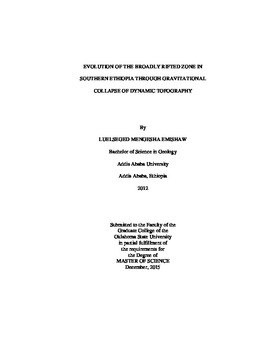| dc.contributor.advisor | La�-d�vila, Daniel A. | |
| dc.contributor.author | Emishaw, Luelseged Mengesha | |
| dc.date.accessioned | 2017-02-22T22:12:33Z | |
| dc.date.available | 2017-02-22T22:12:33Z | |
| dc.date.issued | 2015-12-01 | |
| dc.identifier.uri | https://hdl.handle.net/11244/48975 | |
| dc.description.abstract | The Broadly Rifted Zone (BRZ) is a 300 km wide diffused zone of extension in southern Ethiopia that connects the narrow (50-65 km wide) South Main Ethiopian Rift and the Eastern Branch of the East African Rift System (EARS) represented by the Kenya and Turkana rifts. The topographic features of the BRZ resemble those of the Basin-and-Range in the western United States in that they are characterized by the presence of NE-trending ridges and valleys superimposed on regionally uplifted (~2 km average elevation) terrain. This rift morphology, which is unique to the BRZ within the EARS, resulted from the presence of tilted blocks of Eocene-Pliocene volcanic rocks bounded by steep normal faults that exhibit half-grabens geometry. The tilted blocks rest unconformably on Precambrian crystalline basement and the half-grabens are filled with Miocene-Pliocene sedimentary rocks. The geodynamic mechanism through which the BRZ was developed is not well understood. Previous studies proposed that the BRZ hosts both tectonically active and inactive rift basins resulting from northward propagation of the Kenyan Rift and southward propagation of the Southern Main Ethiopian Rift. In order to understand the relationship between crustal and upper mantle structures beneath the BRZ and its unique morphological expression and extensional style, we first estimated the Moho depths using two-dimensional (2D) radially-averaged power spectral analysis of the World Gravity Map (WGM 2012) satellite gravity data. Subsequently, to verify results from the 2D radially averaged power spectral analysis, we developed lithospheric-scale 2D forward models along E-W profiles across the BRZ and extensional structures to north and south of it. We found that the Moho topography depicts a dome shape beneath the BRZ and it shallows to a minimum depth of 27 km in the central part of this dome. We suggest that the Moho doming, topographic uplift and arching of the crust underlying the BRZ is the result of mantle upwelling beneath the BRZ from a deeper asthenospheric source that changed to northeast lateral flow at shallower depth. This is supported by seismic tomography results which show the presence of low velocity anomaly of shear wave at lithospheric depth of 0-100 km and 100-175 km stretching in a NE-direction from beneath the BRZ to the Afar Depression. At depths between 175-250 km and 250-325 km the low shear wave velocity anomaly became only a broad elliptical feature centered beneath the BRZ. This created gravitationally unstable dynamic topography that triggered extensional collapse leading to the formation of the BRZ as a wide rift within the narrow rift system of the EARS. | |
| dc.format | application/pdf | |
| dc.language | en_US | |
| dc.rights | Copyright is held by the author who has granted the Oklahoma State University Library the non-exclusive right to share this material in its institutional repository. Contact Digital Library Services at lib-dls@okstate.edu or 405-744-9161 for the permission policy on the use, reproduction or distribution of this material. | |
| dc.title | Evolution of the Broadly Rifted Zone in Southern Ethiopia Through Gravitational Collapse of Dynamic Topograpy | |
| dc.contributor.committeeMember | Abdelsalam, Mohamed G. | |
| dc.contributor.committeeMember | Atekwana, Estella A. | |
| osu.filename | Emishaw_okstate_0664M_14424.pdf | |
| osu.accesstype | Open Access | |
| dc.description.department | Geology | |
| dc.type.genre | Thesis | |
| dc.type.material | text | |
